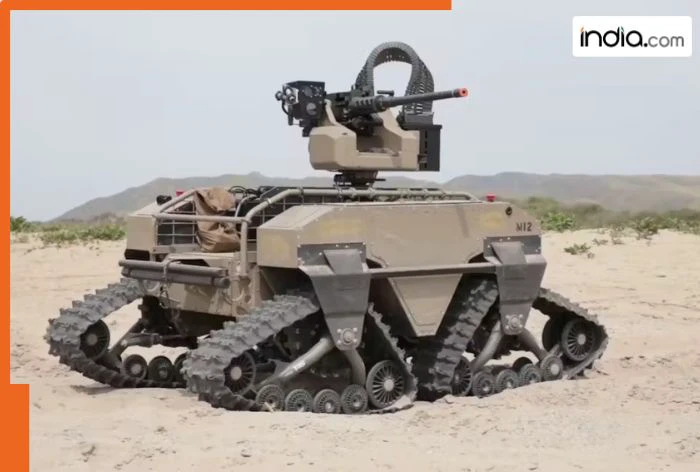It seems that every time we turn on the television, we are witnessing conflict in the world. First, it was Israel-Palestine, then Russia-Ukraine, Pakistan-Afghanistan, China-Taiwan conflict, and now tensions are rising again between India and Pakistan.
It seems that conflict has taken over the headlines, and peace has never looked so far away.
Are China and Pakistan weather allies?
While China might not engage in wars directly, it is completely prepared for proxy wars. Some of its weapons are very modernized and advanced, but China doesn’t show them to the world. Moreover, it didn’t even give supersonic missiles to its weather ally, Pakistan, because it didn’t want to share such high-level technology. This illustrates how savvy and sensible China is prepared to conceal military secrets and military intelligence against its enemies.
What are Unmanned Ground Vehicles (UGVs)?
Xi Jinping’s China is known for its clever war strategies and advanced, powerful weapons. While previously China relied heavily on soldiers, now they are focusing on machines to accomplish its goals, reducing the need for human soldiers. Therefore, it is investing heavily in Unmanned Ground Vehicles (UGVs), robots capable of fighting on the ground without the need for human input. This latest move from China may put India in a very precarious position.
UGVs and Unmanned Ground Vehicles represent machines without a human operator onboard. A UGV may be remotely controlled, but it can be just as destructive as a soldier with training. China is investing heavily in UGVs as part of its modernization plan for its armed forces. UGVs are being used in arduous and remote locations such as the Himalayan border regions to enhance the capabilities of the army to move and conduct operations strategically.
Can Unmanned Ground Vehicles reduce human dependency?
China’s ambition is to gradually reduce dependency on traditional troops and focus on developing defense technology. This interest is primarily concentrated on the Indo-Pacific region. Unmanned Ground Vehicles(UGVs) are easier for the military to use for local surveillance, border security, and logistics. The use of UGVs is on the rise because of the challenges associated with modern warfare.
India faces a new threat! Arunachal Pradesh poses a risk?
China intends to use these vehicles for patrol and observation in demanding areas, including the Himalayan border, hilly regions, snowy routes, and remote areas. The growing use of such vehicles on the Chinese border presents an increasing concern for India, especially relating to vulnerable areas such as Arunachal Pradesh and Tibet, particularly with the presence of unmanned vehicles equipped with machine guns.
Types of unmanned ground vehicles of China? How are they different from the rest?
The most lethal unmanned ground vehicles of China are the Sharp Claw I and Sharp Claw II, two types of Chinese military UGVs. The Sharp Claw I weighs approximately 120 kg and can operate at a range of 6 km. It can traverse rugged terrain and be outfitted with a 7.62 mm light machinegun and has a camera and electro-optical equipment on the hull of the UGV. The Sharp Claw II is the upgraded version, capable of multi-purpose missions. The Sharp Claw II can be used for targeting caves, buildings, and tunnels and includes a remote-controlled weapon firing capability. These UGVs are highly lethal and have unlimited potential in combat engagements and rugged or confined settings.
Other advanced UGVs are also available in China to serve different functions. One of those UGVs is the Mule-200 unmanned robotic vehicle for support roles. The Mule-200 is a support UGV with an operating weight of 500 kg.
The Mule-200 can transport an additional 200 kg. The Mule-200 has a maximum road range of roughly 50 kilometers, and a maximum speed of 50 km/h. The Mule-200 comes standard with ballistic protection for enhanced safety throughout the mission. The Mule-200 was first displayed in February 2020 at the Unmanned Systems Exhibition and Conference in Abu Dhabi.
Robot Dogs/Wolves: China has begun to develop quadrupedal models like the Q-UGV Wolf that specialize in voice recognition, carrying supplies, surveillance, and potential attacks.
Other models, such as Dragon and Horse II 8×8 UGV, are also being deployed at the borders. These vehicles have heavy load-carrying and armored capacity.
China’s UGV market is estimated to be worth…
China’s UGV market was worth an estimated value of 192.3 million in 2023, and is expected to have an estimated value of 321.5 million by 2030. The advanced capabilities of Chinese UGVs show that China is making preparations for dangerous missions at a low cost.
88 Sharp Claw 1 UGVs in Spaas, Tibet, near the Indian border
China deployed 88 Sharp Claw 1 UGVs in Spaas, Tibet, near the Indian border, according to a 2023 article by the Daily Mail, while 38 Sharp Claw units were stationed along the border region. The design of their dangerous equipment and the capability to adapt make them a significant risk to India’s borders, and particularly Arunachal Pradesh, which China has been eying for several years.
